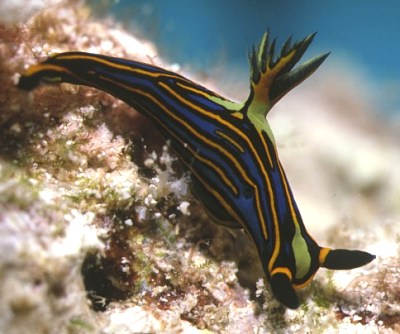
Tambja victoriae
Pola, Cervera & Gosliner, 2005
Order: NUDIBRANCHIA
Suborder: DORIDINA
Superfamily: ANADORIDOIDEA
Family: Polyceridae
Subfamily: Nembrothinae
DISTRIBUTION
Northern Australia, Papua New Guinea, Philippines.
PHOTO
Heron Island, Great Barrier Reef, Australia. 15 metres, December 8, 1997. 28 mm long. Photo: Julie Marshall
The background colour is bright blue with a pattern of longitudinal yellow or yellow-orange lines each outlined with a thin black line. There is a yellow line around the anterior border of the mantle which runs down each side of the body to just behind the gills where it joins in the dorsal midline and runs as a single line some way down the posterior part of the foot. There is a large ovate milky blue-green patch between the rhinophores which continues back to the gills as a thinner yellow line, bordered as usual with black, where it merges with an elongate patch of milky blue-green. The gills sit in the centre of this elongate patch. There are three large, sparsely branched translucent greenish gills. The outer face, or rachis, of the gills is a milky blue-green at the base and yellow above. In both the blue and yellow regions the rachis is outlined with black. The rhinophore clubs are dark blue-black. The raised rhinophore sheaths are dark blue or black with a bright yellow band at the edge. It grows to more than 30 mm in length.
This species has been identified as Roboastra arika Burn, 1967 in a number of illustrated field guides dealing with the Australian fauna although its external shape was clearly not that of a Roboastra. For simplicity, I continued this usage on the Forum. The confusion arose from the original description of the species which was based on a single preserved specimen. In it Burn wrote ‘the live slug was probably bright blue and yellow’ which fits T. victoriae quite well. Roboastra arika is almost certainly a synonym of Roboastra gracilis.
See T. affinis colour group page for a comparison of similarly coloured species.
- Burn, R.F. (1967) Notes on an overlooked nudibranch genus Roboastra Bergh 1877, and two allied genera (Mollusca: Gastropoda). Australian Zoologist, 14: 212-221.
- Pola, M., Cervera, J.L. & Gosliner, T. (2005) Four New Species of Tambja Burn, 1962 (Nudibranchia: Polyceridae) from the Indo-Pacific. Journal of Molluscan Studies, 71: 257-267
Rudman, W.B., 2005 (August 15) Tambja victoriae Pola, Cervera & Gosliner, 2005. [In] Sea Slug Forum. Australian Museum, Sydney. Available from http://www.seaslugforum.net/factsheet/tambvict
Related messages
-
Roboastra arika? from Similan Thailand
From: Napas Golf, March 12, 2007 -
Tambja victoriae from the Philippines
From: Reindert Grooters, September 3, 2005 -
Roboastra arika from Heron Island
From: Julie Marshall, January 23, 2001
